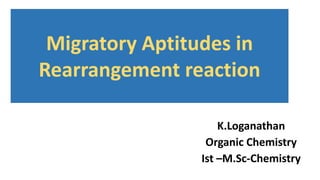
Migratory Aptitudes in Rearrangement Reactions
- 1. Migratory Aptitudes in Rearrangement reaction K.Loganathan Organic Chemistry Ist –M.Sc-Chemistry
- 2. Rearrangement reaction • A rearrangement reaction is a broad class of organic reactions where the carbon skeleton of a molecule is rearranged to give a structural isomer of the original molecule. • Often a substituent moves from one atom to another atom in the same molecule. In the example below the substituent R moves from carbon atom 1 to carbon atom 2 • E.g:
- 3. Migratory Aptitude : • Migratory aptitude is the relative ability of a migrating group to migrate in a rearrangement reaction. • This can be affected by the leaving group (whichever gives a more stable carbocation) depends upon the electron density of the migrating group i.e. Hydride > Phenyl = Tert-Alkyl > Sec-Alkyl > Primary Alkyl > Methyl. • The migratory groups follow the order of increasing stability of carbocation • The real deciding factor is increased electron density at anionic carbon. The more the electron releasing group the more is the migratory aptitude.
- 4. Rearrangement reactions involve the migration of a group or an atom from one center (migration origin) to another (migration terminus) within the same molecule • These rearrangements can be roughly classified on the basis of the nature of the migrating group/atom, • i.Nucleophilic or Anionotropic: migrating group migrates with its electron pair. • ii.Electrophilic or cationotropic: migrating group migrates without its electron pair. • iii.Free radical: migrating group migrates with only one electron
- 5. Nucleophilic rearrangements can take place in two possible modes, • i.Intramolecular : In these migrating group do not completely detach from the migration origin and occurs within the same molecule. • ii. Intermolecular : In these migrating group is detached from the migration origin. In this case, migration of a group/atom can take place to different molecule.
- 6. •General features of 1,2-rearrangement reactions • A species with valence electron sextet either carbocation or carbenium ion is involved. • Thermodynamic driving force for an 1,2-rearrangement will be significant if rearrangement leads to a structure with octet on all atoms or generates some other more stable carbocation . Alternatively, reduction in angle strain can also provide the driving force. • Heterolysis of such a bond would provide a carbocation • Departure of the leaving group is then assisted by neighboring group
- 7. Mechanism of Nucleophilic Rearrangement • Broadly these reactions consists of three steps; • First step is generation of electron deficient centre in the molecule. As the migrating group migrates with electron pair, the migration terminus must have an incomplete octet. This can be obtained in two ways , 1) Through carbocation: Carbocations can be formed in various ways. The most common being dehydration of alcohol 2)Through nitrenes : nitrenes can be formed by decomposition of acyl azides.
- 8. In the second step ,Migrating group migrates to the electron deficient centre with its electron pair creating new electron deficient centre. In third step, newly formed electron deficient centre acquires octet either by accepting a nucleophile or excluding proton. • It is observed in many cases that either two or all three steps take place simultaneously. As seen in many cases SN1type of first step is commonly followed by rearrangement to give a more stable carbocation. • It is proved by the fact that the rate of reaction increases with the ionizing power of solvent and it is unaffected by concentration of base. • It has been shown that the rate of migration increases with degree of electron deficiency at migration terminus.
- 9. Nature of Migration • Majority of rearrangements are intramolecular • Another form of evidence can be gathered by using a chiral migrating group. If the configuration at the migrating group is retained in the product, it is quite likely that the rearrangement is intramolecular In this example inversion at the migration terminus takes place. The reaction involves diazotization and intramolecular 1,2-phenyl migration.
- 10. Migratory aptitude • In many reactions like Hofmann, Curtis etc., identity of the group that migrates is quite clear. However, in certain other reactions like Beckman rearrangement, there are more than one choice. In such situations the question of which group migrates depends on several factors (such as the geometry of molecule). • In the case of Wagner-Meerwein and Pinacol rearrangement, there are many choices, as substrate contains several groups, that have similar propensity for migration. Such reactions are used for the study of relative migratory aptitude
- 11. Hydroxyl group is lost from carbon bearing two phenyl groups as it provides a more stable carbocation. The stability of the carbocation is enhanced by group in the order aryl > alkyl > H.
- 13. • Many factors control migratory aptitude. These are (a) conformational features, (b)relative ability of the groups at the migration origin that can stabilize the developing positive charge. In the following example, involving the decomposition of tosylate, only phenyl group migrates The phenyl group in the example assists the departure of the tosyl group
- 14. Some general trends in the migrating aptitude of different groups • Aryl groups exhibits higher propensity for migration than that of alkyl groups. • Migratory aptitude of hydrogen is unpredictable. Hence, mixture of migrated products are obtained. • In the case of aryl groups, those with electron donating substituents at the meta or para positions migrates preferentially over those containing substituents at the ortho position. • Aryl group containing electron withdrawing groups show reduced migratory aptitude.
